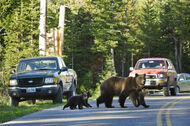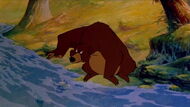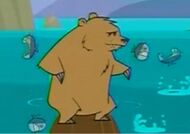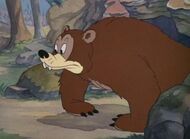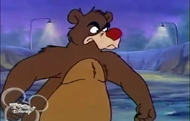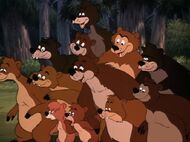The grizzly bear (Ursus arctos ssp.) is any North American morphological form or subspecies of brown bear, including the mainland grizzly (Ursus arctos horribilis), Kodiak bear (U. a. middendorffi), peninsular grizzly (U. a. gyas), and the recently extinct California grizzly (U. a. californicus†) and Mexican grizzly bear (U. a. nelsoni†). Scientists do not use the name grizzly bear but call it the North American brown bear. It should not be confused with the black grizzly or Ussuri brown bear (U. a. lasiotus) which is another giant brown bear inhabiting Russia, Northern China, and Korea.
Appearance[]
Most adult female grizzlies weigh 130–180 kg (290–400 lb), while adult males weigh on average 180–360 kg (400–790 lb). Average total length in this subspecies is 198 cm (6.50 ft), with an average shoulder height of 102 cm (3.35 ft) and hindfoot length of 28 cm (11 in). Newborn bears may weigh less than 500 grams (1.1 lb). In the Yukon River area, mature female grizzlies can weigh as little as 100 kg (220 lb). One study found that the average weight for an inland male grizzly was around 272 kilograms (600 lb) and the average weight for a coastal male was around 408 kilograms (900 lb). For a female, these average weights would be 136 kilograms (300 lb) inland and 227 kilograms (500 lb) coastal, respectively. On the other hand, an occasional huge male grizzly has been recorded which greatly exceeds ordinary size, with weights reported up to 680 kg (1,500 lb). A large coastal male of this size may stand up to 3 metres (9.8 ft) tall on its hind legs and be up to 1.5 metres (4.9 ft) at the shoulder.
Although variable in color from blond to nearly black, grizzly bear fur is typically brown with darker legs and commonly white or blond tipped fur on the flank and back. A pronounced hump appears on their shoulders; the hump is a good way to distinguish a grizzly bear from a black bear, as black bears do not have this hump. Aside from the distinguishing hump a grizzly bear can be identified by a "dished in" profile of their face with short, rounded ears, whereas a black bear has a straight face profile and longer ears. A grizzly bear can also be identified by its rump, which is lower than its shoulders, while a black bear's rump is higher. A grizzly bear's front claws measure about 2-4 inches in length and a black bear's measure about 1-2 inches in length.
Range and Population[]
Brown bears are found in Asia, Europe, and North America, giving them the widest ranges of bear species. They also inhabited North Africa and the Middle East. In North America, grizzly bears previously ranged from Alaska down to Mexico and as far east as the western shores of Hudson Bay; the species is now found in Alaska, south through much of western Canada, and into portions of the northwestern United States (including Idaho, Montana, Washington, and Wyoming), extending as far south as Yellowstone and Grand Teton National Parks. It is most commonly found in Canada. In Canada, there are approximately 25,000 grizzly bears occupying British Columbia, Alberta, the tundra areas of the Ungava Peninsula and the northern tip of Labrador-Quebec, the Yukon, the Northwest Territories, Nunavut, and the northern part of Manitoba. In British Columbia, grizzly bears inhabit approximately 90% of their original territory. There were approximately 25,000 grizzly bears in British Columbia when the European settlers arrived. However, population size has since significantly decreased due to hunting and habitat loss. In 2008, it was estimated there were 16,014 grizzly bears. Population estimates for British Columbia are based on hair-snagging, DNA-based inventories, mark-and-recapture, and a refined multiple regression model. In 2003, researchers from the University of Alberta spotted a grizzly on Melville Island in the high Arctic, which is the most northerly sighting ever documented.
The Alaskan population of 30,000 individuals is the highest population of any province/state in North America. Populations in Alaska are densest along the coast, where food supplies such as salmon are more abundant. The Admiralty Island National Monument protects the densest population — 1,600 bears on a 1,600-square mile island.
Longevity[]
The grizzly bear is, by nature, a long-living animal. Females live longer than males due to their less dangerous life, avoiding the seasonal breeding fights males engage in. The average lifespan for a male is estimated at 22 years, with that of a female being slightly longer at 26. The oldest wild inland grizzly was 34 years old in Alaska; the oldest coastal bear was 39. Captive grizzlies have lived as long as 44 years, but most grizzlies die in their first few years of life from predation or hunting.
Hibernation[]
Grizzly bears hibernate for 5–7 months each year except where the climate is warm, as the California grizzly did not hibernate. During this time, female grizzly bears give birth to their offspring, who then consume milk from their mother and gain strength for the remainder of the hibernation period. To prepare for hibernation, grizzlies must prepare a den, and consume an immense amount of food as they do not eat during hibernation. Grizzly bears do not defecate or urinate throughout the entire hibernation period. The male grizzly bear's hibernation ends in early to mid-March, while females emerge in April or early May.
In preparation for winter, bears can gain approximately 180 kg (400 lb), during a period of hyperphagia, before going into hibernation. The bear often waits for a substantial snowstorm before it enters its den: such behavior lessens the chances predators will find the den. The dens are typically at elevations above 1,800 m (5,900 ft) on north-facing slopes. There is some debate amongst professionals as to whether grizzly bears technically hibernate: much of this debate revolves around body temperature and the ability of the bears to move around during hibernation on occasion. Grizzly bears can "partially" recycle their body wastes during this period. Although inland or Rocky Mountain grizzlies spend nearly half of their life in dens, coastal grizzlies with better access to food sources spend less time in dens. In some areas where food is very plentiful year round, grizzly bears skip hibernation altogether.
Reproduction[]
Except for females with cubs, grizzlies are normally solitary, active animals, but in coastal areas, grizzlies gather around streams, lakes, rivers, and ponds during the salmon spawn. Every other year, females (sows) produce one to four young (usually two) which are small and weigh only about 500 grams (1 lb) at birth. A sow is protective of her offspring and will attack if she thinks she or her cubs are threatened.
Grizzly bears have one of the lowest reproductive rates of all terrestrial mammals in North America. This is due to numerous ecological factors. Grizzly bears do not reach sexual maturity until they are at least five years old. Once mated with a male in the summer, the female delays embryo implantation until hibernation, during which miscarriage can occur if the female does not receive the proper nutrients and caloric intake. On average, females produce two cubs in a litter and the mother cares for the cubs for up to two years, during which the mother will not mate. Once the young leave or are killed, females may not produce another litter for three or more years, depending on environmental conditions. Male grizzly bears have large territories, up to 4,000 km2 (1,500 sq mi), making finding a female scent difficult in such low population densities. Population fragmentation of grizzlies may destabilize the population from inbreeding depression. The gestation period for grizzly bears is approximately 180–250 days.
Litter size is between one and four cubs, averaging twins or triplets. Cubs are always born in the mother's winter den while she is in hibernation. Female grizzlies are fiercely protective of their cubs, being able to fend off predators as large as male bears bigger than they are in defense of the cubs. Cubs feed entirely on their mother's milk until summer comes, after which they still drink milk but begin to eat solid foods. Cubs gain weight rapidly during their time with the mother — their weight will have ballooned from 4.5 to 45 kg (10 to 99 lb) in the two years spent with the mother. Mothers may see their cubs in later years but both avoid each other.
Diet[]
Although grizzlies are of the order Carnivora and have the digestive system of carnivores, they are normally omnivores: their diets consist of both plants and animals. They have been known to prey on large mammals, when available, such as moose, elk, caribou, white-tailed deer, mule deer, bighorn sheep, bison, and even black bears; though they are more likely to take calves and injured individuals rather than healthy adults. Grizzly bears feed on fish such as salmon, trout, and bass, and those with access to a more protein-enriched diet in coastal areas potentially grow larger than inland individuals. Grizzly bears also readily scavenge food or carrion left behind by other animals. Grizzly bears will also eat birds and their eggs, and gather in large numbers at fishing sites to feed on spawning salmon. They frequently prey on baby deer left in the grass, and occasionally they raid the nests of raptors such as bald eagles.
Canadian or Alaskan grizzlies are larger than those that reside in the American Rocky Mountains. This is due, in part, to the richness of their diets. In Yellowstone National Park in the United States, the grizzly bear's diet consists mostly of whitebarkpine nuts, tubers, grasses, various rodents, army cutworm moths, and scavenged carcasses. None of these, however, match the fat content of the salmon available in Alaska and British Columbia. With the high fat content of salmon, it is not uncommon to encounter grizzlies in Alaska weighing 540 kg (1,200 lb). Grizzlies in Alaska supplement their diet of salmon and clams with sedge grass and berries. In areas where salmon are forced to leap waterfalls, grizzlies gather at the base of the falls to feed on and catch the fish. Salmon are at a disadvantage when they leap waterfalls because they cluster together at their bases and are therefore easier targets for the grizzlies. Grizzly bears are well-documented catching leaping salmon in their mouths at Brooks Falls in Katmai National Park and Preserve in Alaska. They are also very experienced in chasing the fish around and pinning them with their claws. At such sites such as Brooks Falls and McNeil Falls in Alaska, big male grizzlies fight regularly for the best fishing spots. Grizzly bears along the coast also forage for razor clams, and frequently dig into the sand to seek them. During the spring and fall, directly before and after the salmon runs, berries and grass make up the mainstay of the diets of coastal grizzlies.
Inland grizzlies may eat fish too, most notably in Yellowstone grizzlies eating Yellowstone cutthroat trout. The relationship with cutthroat trout and grizzlies is unique because it is the only example where Rocky Mountain grizzlies feed on spawning salmonid fish. However, grizzly bears themselves and invasive lake trout threaten the survival of the trout population and there is a slight chance that the trout will be eliminated.
Meat, as already described, is an important part of a grizzly's diet. Grizzly bears occasionally prey on small mammals, such as marmots, ground squirrels, lemmings, and voles. The most famous example of such predation is in Denali National Park and Preserve, where grizzlies chase, pounce on, and dig up Arctic ground squirrels to eat. In some areas, grizzly bears prey on hoary marmots, overturning rocks to reach them, and in some cases preying on them when they are in hibernation. Larger prey includes bison and moose, which are sometimes taken by bears in Yellowstone National Park. Because bison and moose are dangerous prey, grizzlies usually use cover to stalk them and/or pick off weak individuals or calves. Grizzlies in Alaska also regularly prey on moose calves, which in Denali National Park may be their main source of meat. In fact, grizzly bears are such important predators of moose and elk calves in Alaska and in Yellowstone, that they may kill as many as 51 percent of elk or moose calves born that year. Grizzly bears have also been blamed in the decline of elk in Yellowstone National Park when the actual predators were thought to be gray wolves. In northern Alaska, grizzlies are a significant predator of caribou, mostly taking sick or old individuals or calves. Several studies show that grizzly bears may follow the caribou herds year-round in order to maintain their food supply. In northern Alaska, grizzly bears often encounter muskox. Despite the fact that muskox do not usually occur in grizzly habitat and that they are bigger and more powerful than caribou, predation on muskox by grizzlies has been recorded.
Grizzly bears along the Alaskan coast also scavenge on dead or washed up whales. Usually such incidents involve only one or two grizzlies at a carcass, but up to ten large males have been seen at a time eating a dead humpback whale. Dead seals and sea lions are also consumed.
Although the diets of grizzly bears vary extensively based on seasonal and regional changes, plants make up a large portion of them, with some estimates as high as 80–90%. Various berries constitute an important food source when they are available. These can include blueberries, blackberries (Rubus fruticosus), salmon berries (Rubus spectabilis), cranberries (Vaccinium oxycoccos), buffalo berries (Shepherdia argentea), soapberries (Shepherdia canadensis), and huckleberries (Vaccinium parvifolium), depending on the environment. Insects such as ladybugs, ants, and bees are eaten if they are available in large quantities. In Yellowstone National Park, grizzly bears may obtain half of their yearly caloric needs by feeding on miller moths that congregate on mountain slopes. When food is abundant, grizzly bears will feed in groups. For example, many grizzly bears will visit meadows right after an avalanche or glacier slide. This is due to an influx of legumes, such as Hedysarum, which the grizzlies consume in massive amounts. When food sources become scarcer, however, they separate once again.






